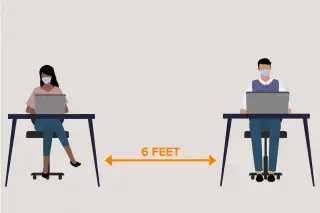Social Distancing at Work Is Going to Be Even Harder Than We Think

It’s been four months since workers across the country said goodbye to their colleagues and offices. You might miss the coffee mug you left on your desk, your company’s snack supply, or even your commute. And as states reopen, it could be tempting for employers to return to business as usual. But that doesn’t mean they should.
Companies face strict guidelines from the Centers of Disease Control and Prevention (CDC) if they choose to re-open. Among them is something you've likely heard over and over since the pandemic began: stay six feet apart from other people. But with open floors, conference rooms and communal spaces like kitchens—where people chat and mingle all day—is it even possible to socially distance in the modern office?
Money put that question to some public health experts, and got a resounding "yes." But only if every single employee follows every single rule, every single time.
“There’s nothing easy about this and it does require strict adherence to the guidelines or it’s not going to work,” says Dr. David Weber, medical director of hospital epidemiology at the University of North Carolina Medical Center.
Keep your friends ... at a distance
Staying six feet away from your coworkers might be physically possible at your office—heck, it might even be easy. But don't overlook the psychological and social hurdles it presents, says Melissa Perry, professor of environmental and occupational Health at the George Washington University.
“Having to be in 'compliance mode' in a very strict and formal way is so unnatural for us psychologically,” Perry says. “Recognizing that it’s challenging will give us more resolve."
Returning to the office—where you’ll always be in some kind of contact with your colleagues—requires thinking about protecting a group of people, instead of just yourself, she adds.
We have a natural tendency to think our friends don't have the virus because, well, they're our friends, Weber says. But even if you trust that your office BFF has followed the CDC’s guidance over the last few months, that doesn’t mean you can immediately start popping by their desk, sitting next to them at lunch, or otherwise throw the rules out the window.
“You need to essentially assume everyone you’re with is infectious,” he says.
Prepare for change
Companies have a legal obligation to maintain a safe, healthy workspace for employees. To make physical distancing possible, yours will probably need to reconfigure some things before you return.
Guidance from the CDC tells employers to move all seats, furniture and workstations to maintain that six-foot distance—and to turn over or cover chairs in communal spaces (like reception) so not all are used at once. The agency also recommends using visual cues like signs to show people where they can stand to keep apart in all areas of a building, including entrance, exits and parking lots.
If you're in management, you may need to "think outside of the box" to meet the CDC requirements, Weber says.
It might be worth putting up temporary plexiglass walls between workstations, he says. And if your break room is small, consider setting up a tent outside for additional space.
Rethink that 9 a.m. commute
Staggering schedules is one of the first things employers should be considering (next to continuing to allow people to work from home if possible), says Dr. Joshua Sharfstein, vice dean at the Johns Hopkins Bloomberg School of Public Health.
The fewer people around, the better, he says. Especially when it comes to traditionally cramped spaces like elevators — which should only have a few people on at a time, and no large crowds waiting for the next one, he says.
The American Industrial Hygiene Association (AIHA) recommends staggering lunch schedules as well, especially for offices that have cafeteria-style services or food courts.
Another way to dial back person-to-person contact is to keep meetings virtual, even after you go back to the office. If employees must conduct in-person meetings, AIHA recommends limiting them to 10 people or less, and to discourage socializing before and after.
Wear a frigging mask
There are lots of other things employers can do to slow the spread of the virus—like improve central air filtration, disinfect surfaces, and replace high-touch items like snacks with single-serving packages. But whether or not your company is taking those steps, it's up to you to keep wearing that mask you've probably become pretty accustomed to.
“That doesn't mean wearing it 80% of the time and pulling it down to talk to someone at the water cooler,” Weber says. “There needs to be 100% compliance for this to work, or as near as you can get to that.”
The one exception is people who have their own office, and can take off the mask when they're alone with the door closed, he adds.
But ingrained behavior is modeled from the top down, so when management is around junior staff, it's essential their mouths and noses are covered.
"Senior people have to follow exactly what they preach," Weber says.
More from Money:
Napper's Delight: How Coronavirus Normalized the Afternoon Snooze for America's Burnt-Out Workforce
A Detailed Guide to Every State Extending Unemployment Benefits
How to Turn a Job Offer at a New Company Into a Raise at Your Current Gig